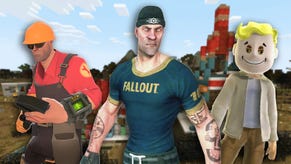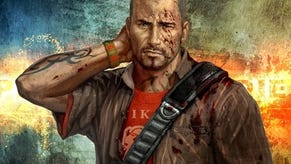Splash Damage reflects on Brink
It "tried to be new and different".
Splash Damage has gone into detail on the design of multiplayer-focused first-person shooter Brink.
During a GDC Europe 2011 session this morning attended by Eurogamer, lead designer Neil Alphonso analysed Brink's four design pillars: blended game modes, objective and team based gameplay, the SMART system, and player customisation and persistent levelling.
"Brink tried to be something new and different in several areas," Alphonso said. "In hindsight we perhaps strayed away from convention a bit too much in some areas.
"But several of Brink's key features resonated really well with our audience, along with continuing to work on tweaking and refining the gameplay now the game is out in the wild. We're taking a lot of these lessons on board for our future projects."
Brink attempted to fuse single-player and competitive multiplayer modes, blurring the line between the two by suggesting objectives to the player dynamically. In single-player, Brink used AI priority scripting, which adjusted how much the AI cared about an objective, to determine how bots acted.
"This was necessary just to get the [bots] to use the levels properly," Alphonso said. "Adjusting them dynamically created a rhythm that matched multiplayer in a single-player game. But it kind of makes the AI seem stupid sometimes because they won't just go for the objective as much as they can at the very beginning.
"We did this in part because we got a lot of feedback that it felt like the player wasn't driving the action enough. The way the game worked, it sometimes meant the player could play poorly and win, like literally at some points they could sit in the spawn area and their team would go an win. Or you could kick absolute ass and still lose. This smoothed that out a bit, but it didn't really change the fundamental nature of that system.
"Another thing worth noting is gamers are smart."
Neil Alphonso, lead designer, Brink
"Another thing worth noting is gamers are smart. This became really transparent to a lot of them and they found it pretty frustrating. Some didn't care. They thought it was acceptable and the game meant for playing multiplayer anyway. But others... we gotta a lot of hate for it. Put it that way."
Alphonso went on to discuss the game's narrative - "which had to take a back seat". "People reacted pretty differently to the way we approached our narrative," Alphonso said. "Some would say there's no story to speak of, which I would beg to differ with. But some loved the setting and the context we'd given the action. There's a lot there for people to read into it. But we don't spoon feed it to people, which is maybe what some people were looking for.
"So in the end, essentially when the game is viewed as a highly contextualised multiplayer experience, it does really well. But if you view it as a cinematic single-player cinematic experience, it doesn't really hold up."
Eurogamer's Brink review scored 8/10, with Simon Parkin calling it "an exceptional team shooter, smart, supremely well balanced and with a unique, exciting art style".
In analysing the reaction to the game, Splash Damage found Brink was better received in Europe than it was in the US, particularly regarding the team play.
"We got pretty different views across the globe about it," Alphonso revealed. "It was far more accepted in Europe than it was in America. They [Americans] prize individualism a lot more. I don't think it caught on quite as much there as it did here. It's something I saw over and over again as we were developing it. It's a point of personal fascination. I don't mean to slander them all, though. Some absolutely love it."
"[Brink] was far more accepted in Europe than it was in America."
Neil Alphonso
Brink's SMART system - Smooth Movement Across Random Terrain – was a Parkour-inspired design that allowed players to move about the maps quickly. But according to Splash Damage the feature went underused.
"There are three major reasons, along with a whole host of minor ones, why SMART wasn't used by more players," Alphonso said. "Players will go with what they know when that's a viable option."
He also pointed to the busy user interface in Brink, which meant SMART "got lost". Focusing on the path of least resistance, however, is a "human tenancy". People are lazy: "I honestly think this translates into the digital realm," Alphonso mused. "Behaviours from reality, you have to take the time to let the player gradually unlearn them so they can replace them with the new ones."
Alphonso also addressed a common player complaint that there was little to do once the maximum level of 20 was reached – and that levelling and unlocking sped by too quickly.
"We felt the game really started at the max level. We wanted to remove the XP grind needed in order to get there, and viewed the levelling experience as more educational," Alphonso said.
"There was still a perception among a lot of players there was nothing to do once they reached level 20, which was a bit of a surprise to us. You're supposed to just make more characters and have fun doing it, because, if you're not having fun then why are you playing?
"People really do need an explicit measurement, like a bigger number next to their name on the scoreboard than somebody else."
Neil Alphonso
"But we were really surprised at how people took this. We thought fun was an obvious goal playing the game. It's evident that especially the way the industry is today, people really do need an explicit measurement, like a bigger number next to their name on the scoreboard than somebody else."
So, what might have Splash Damage done differently? Alphonso answered by suggesting he would have reigned in the "expanding matrix of possibilities within the game".
"It would have been a lot simpler and would have taken a lot less resources to reduce how complex things can get in the end. It gets harder and harder to test. You have more and more variation. And ultimately, a lot of people won't appreciate that because they just don't see it – a lot of people who gave up the game very early.
"It does give you depth, but you're better off doing that with tweaks and giving them a more polished experience all around.
"I could talk a day about what I would do differently, but that's a big one."









